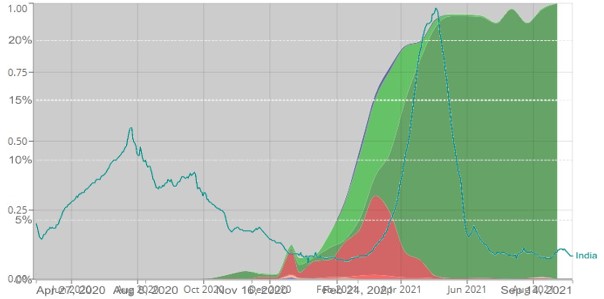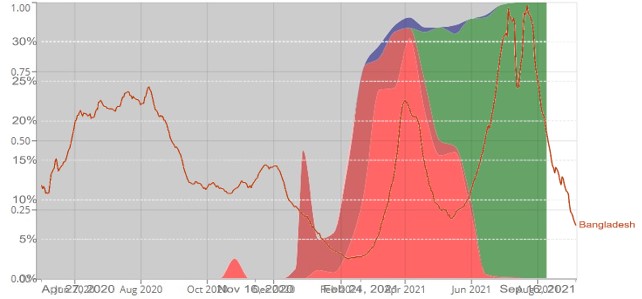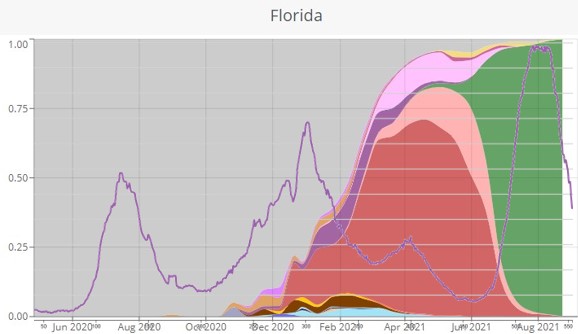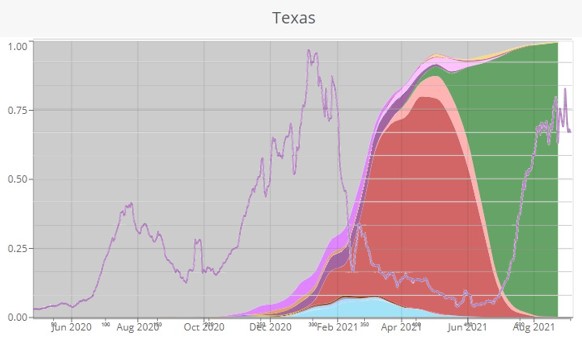As an addendum to my piece yesterday on the evidence for variants driving Covid surges, a comparison between India and neighbouring Bangladesh is illuminating. Once again, the curves below are the positive test rate and they are superimposed on the graphs of variant proportions over time from the CoVariants website.

India has had one large surge in 2021 so far, occurring in spring and associated with the Delta variant (which was first identified there; in dark green). It has had no summer surge, and no new variant since.

Bangladesh, on the other hand, has had two peaks in 2021, a spring peak associated with the Beta variant (light red) and a summer one associated with the Delta variant.
Beta appears to have been pushed out by Delta in India during the spring, whereas Bangladesh was hit by the two variants in succession.
The presence of two peaks associated with two variants in Bangladesh, in spring and summer, contrasted with the single peak in India in spring associated with one variant, is further evidence that variants are key drivers of surges.
Identifying variants as key drivers of Covid surges does not in my view support the lockdown narrative that sees ‘scariants’ as reasons to maintain Covid restrictions and keep pushing endless vaccine boosters. From a sceptical point of view a big advantage of recognising that variants are key drivers of surges is that it implies that the rises and falls in infection curves are not primarily related to imposing or lifting restrictions but to the arrival of new variants and the subsequent re-establishing of herd immunity to the virus.
To illustrate, here are three U.S. states which famously lifted restrictions despite dire warnings of what would happen if they did. (Note: the curves here, from the CDC, are for raw numbers of reported infections rather than the positive rate.)

Florida lifted restrictions in autumn 2020 and went through the winter with no state-level restrictions. Yet its winter wave peaked and declined just like those in lockdown states. There was a small peak in the spring, but this was associated with the Alpha variant (dark red), not with the lifting of restrictions. This too declined, before the appearance in summer of a large surge associated with the Delta variant, which is now in decline. The imposing or lifting of restrictions played no part in this pattern, which is very similar to elsewhere.

Texas had a large winter wave, after which the state lifted restrictions in March, which led to no new surge. A slower decline in spring might be associated with Alpha but there is no clear peak. Come summer, however, and there is a big new surge associated with the arrival of Delta.

Mississippi also lifted restrictions in March and saw no new surge, with only the slightest bump in the spring being discernible, associated with Alpha. Come summer, however, and there is a big surge associated with Delta, now in decline.
With no restrictions in place, the lifting of restrictions in these states cannot be blamed for causing the summer surges just as the imposing of restrictions cannot be credited with causing the falls. Instead, what we have are further examples of a surge occurring upon the arrival of a new variant and shortly peaking and dropping, presumably as herd immunity to that variant is established. This is very helpful for explaining the behaviour of the virus and why it has little or nothing to do with the imposing or lifting of restrictions.











To join in with the discussion please make a donation to The Daily Sceptic.
Profanity and abuse will be removed and may lead to a permanent ban.